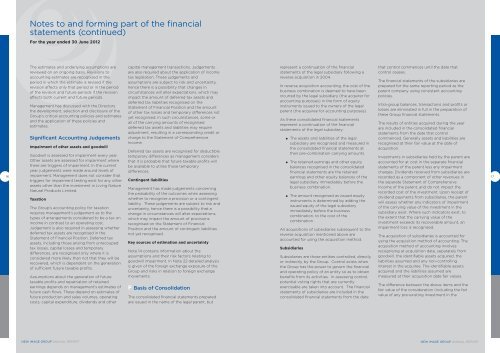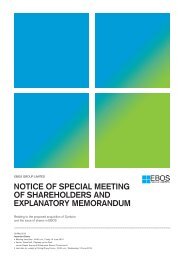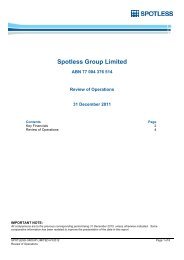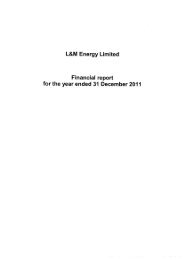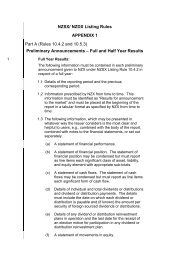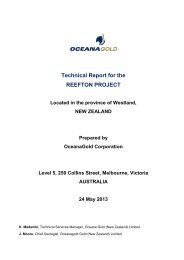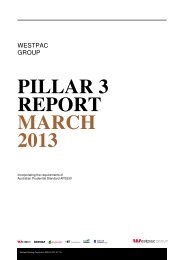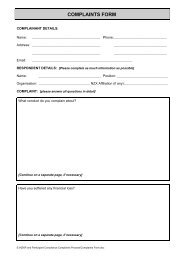New Image Annual Report 2012 concept.indd - NZX
New Image Annual Report 2012 concept.indd - NZX
New Image Annual Report 2012 concept.indd - NZX
Create successful ePaper yourself
Turn your PDF publications into a flip-book with our unique Google optimized e-Paper software.
Notes to and forming part of the financial<br />
statements (continued)<br />
For the year ended 30 June <strong>2012</strong><br />
16<br />
The estimates and underlying assumptions are<br />
reviewed on an ongoing basis. Revisions to<br />
accounting estimates are recognised in the<br />
period in which the estimate is revised if the<br />
revision affects only that period or in the period<br />
of the revision and future periods if the revision<br />
affects both current and future periods.<br />
Management has discussed with the Directors<br />
the development, selection and disclosure of the<br />
Group’s critical accounting policies and estimates<br />
and the application of these policies and<br />
estimates.<br />
Significant Accounting Judgements<br />
Impairment of other assets and goodwill<br />
Goodwill is assessed for impairment every year.<br />
Other assets are assessed for impairment where<br />
there are triggers of impairment. In the current<br />
year, judgements were made around levels of<br />
impairment. Management does not consider that<br />
triggers for impairment testing exist for any other<br />
assets other than the investment in Living Nature<br />
Natural Products Limited.<br />
Taxation<br />
The Group’s accounting policy for taxation<br />
requires management’s judgement as to the<br />
types of arrangements considered to be a tax on<br />
income in contrast to an operating cost.<br />
Judgement is also required in assessing whether<br />
deferred tax assets are recognised in the<br />
Statement of Financial Position. Deferred tax<br />
assets, including those arising from unrecouped<br />
tax losses, capital losses and temporary<br />
differences, are recognised only where it is<br />
considered more likely than not that they will be<br />
recovered, which is dependent on the generation<br />
of sufficient future taxable profits.<br />
Assumptions about the generation of future<br />
taxable profits and repatriation of retained<br />
earnings depends on management’s estimates of<br />
future cash flows. These depend on estimates of<br />
future production and sales volumes, operating<br />
costs, capital expenditure, dividends and other<br />
capital management transactions. Judgements<br />
are also required about the application of income<br />
tax legislation. These judgements and<br />
assumptions are subject to risk and uncertainty,<br />
hence there is a possibility that changes in<br />
circumstances will alter expectations, which may<br />
impact the amount of deferred tax assets and<br />
deferred tax liabilities recognised on the<br />
Statement of Financial Position and the amount<br />
of other tax losses and temporary differences not<br />
yet recognised. In such circumstances, some or<br />
all of the carrying amounts of recognised<br />
deferred tax assets and liabilities may require<br />
adjustment, resulting in a corresponding credit or<br />
charge to the Statement of Comprehensive<br />
Income.<br />
Deferred tax assets are recognised for deductible<br />
temporary differences as management considers<br />
that it is probable that future taxable profits will<br />
be available to utilise those temporary<br />
differences.<br />
Contingent liabilities<br />
Management has made judgements concerning<br />
the probability of the outcomes when assessing<br />
whether to recognise a provision or a contingent<br />
liability. These judgements are subject to risk and<br />
uncertainty, hence there is a possibility that a<br />
change in circumstances will alter expectations,<br />
which may impact the amount of provisions<br />
recognised on the Statement of Financial<br />
Position and the amount of contingent liabilities<br />
not yet recognised.<br />
Key sources of estimation and uncertainty<br />
Note 14 contains information about the<br />
assumptions and their risk factors relating to<br />
goodwill impairment. In Note 22 detailed analysis<br />
is given of the foreign exchange exposure of the<br />
Group and risks in relation to foreign exchange<br />
movements.<br />
F Basis of Consolidation<br />
The consolidated financial statements prepared<br />
are issued in the name of the legal parent, but<br />
represent a continuation of the financial<br />
statements of the legal subsidiary following a<br />
reverse acquisition in 2004.<br />
In reverse acquisition accounting, the cost of the<br />
business combination is deemed to have been<br />
incurred by the legal subsidiary (the acquirer for<br />
accounting purposes) in the form of equity<br />
instruments issued to the owners of the legal<br />
parent (the acquiree for accounting purposes).<br />
As these consolidated financial statements<br />
represent a continuation of the financial<br />
statements of the legal subsidiary:<br />
The assets and liabilities of the legal<br />
subsidiary are recognised and measured in<br />
the consolidated financial statements at<br />
their pre-combination carrying amounts.<br />
The retained earnings and other equity<br />
balances recognised in the consolidated<br />
financial statements are the retained<br />
earnings and other equity balances of the<br />
legal subsidiary immediately before the<br />
business combination.<br />
The amount recognised as issued equity<br />
instruments is determined by adding the<br />
issued equity of the legal subsidiary<br />
immediately before the business<br />
combination, to the cost of the<br />
combination.<br />
All acquisitions of subsidiaries subsequent to the<br />
reverse acquisition mentioned above are<br />
accounted for using the acquisition method.<br />
Subsidiaries<br />
Subsidiaries are those entities controlled, directly<br />
or indirectly, by the Group. Control exists when<br />
the Group has the power to govern the financial<br />
and operating policy of an entity so as to obtain<br />
benefits from its activities. In assessing control,<br />
potential voting rights that are currently<br />
exercisable are taken into account. The financial<br />
statements of subsidiaries are included in the<br />
consolidated financial statements from the date<br />
that control commences until the date that<br />
control ceases.<br />
The financial statements of the subsidiaries are<br />
prepared for the same reporting period as the<br />
parent company using consistent accounting<br />
policies.<br />
Intra-group balances, transactions and profits or<br />
losses are eliminated in full in the preparation of<br />
these Group financial statements.<br />
The results of entities acquired during the year<br />
are included in the consolidated financial<br />
statements from the date that control<br />
commenced. Generally assets and liabilities are<br />
recognised at their fair value at the date of<br />
acquisition.<br />
Investments in subsidiaries held by the parent are<br />
accounted for at cost in the separate financial<br />
statements of the parent less any impairment<br />
charges. Dividends received from subsidiaries are<br />
recorded as a component of other revenues in<br />
the separate Statement of Comprehensive<br />
Income of the parent, and do not impact the<br />
recorded cost of the investment. Upon receipt of<br />
dividend payments from subsidiaries, the parent<br />
will assess whether any indicators of impairment<br />
of the carrying value of the investment in the<br />
subsidiary exist. Where such indicators exist, to<br />
the extent that the carrying value of the<br />
investment exceeds its recoverable amount, an<br />
impairment loss is recognised.<br />
The acquisition of subsidiaries is accounted for<br />
using the acquisition method of accounting. The<br />
acquisition method of accounting involves<br />
recognising at acquisition date, separately from<br />
goodwill, the identifiable assets acquired, the<br />
liabilities assumed and any non-controlling<br />
interest in the acquiree. The identifiable assets<br />
acquired and the liabilities assumed are<br />
measured at their acquisition date fair values.<br />
The difference between the above items and the<br />
fair value of the consideration (including the fair<br />
value of any pre-existing investment in the<br />
17<br />
NEW IMAGE GROUP ANNUAL REPORT<br />
NEW IMAGE GROUP ANNUAL REPORT


